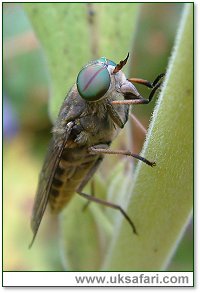
|

|
|
 Sent
to you Sent
to you
by e-mail
|
|
Simply
enter your details and hit the send button
more
info |
|


Click Here

Links
Advertise
Terms of Use
Contributors
About Us
Contact Us
|
 |
Go back
 | Bookmark
| Bookmark
 | Print Page
| Print Page  | E-Mail Us
| E-Mail Us 
 

Photo: G. Bradley
|
|
UK
Safari Tip:
A great way to see all the details on these insects and other small
creatures is with a special magnifier box - click
here
|
|
Latin name: Tabanidae
Size: From 8 to 23mms depending on the species
Distibution: Found throughout the UK.
Months seen: May to September
Food: Females suck the blood of mammals. The males are nectar feeders.
Habitat: Fields and hedgerows, especially near water
Special features: Although the male horse fly is a nectar feeder, the
female horse fly can give a painful bite with their
sharp, piercing mouthparts. The bite leaves a triangular hole in the skin and
can cause a large swelling.
Unlike mosquitoes, they make a much lower pitched humming noise when they fly,
so you don't always hear them coming.
Their one redeeming characteristic is their amazing eyes, which feature bands of
brilliant colours.
The maggot-like larvae of horse flies live in mud, feeding on decaying vegetable
matter or small creatures (depending on the species).

UK Safari Creepy-Crawlies Section
|
 |

|